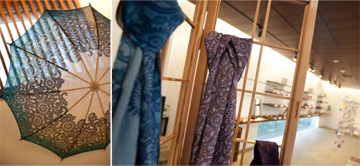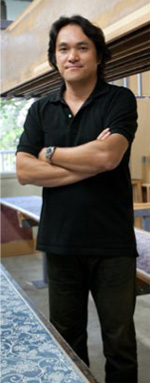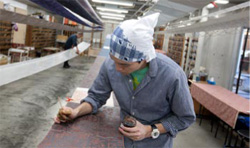Home > Highlighting JAPAN > Highlighting Japan DECEMBER 2011 > Fabrics to Dye For
Highlighting JAPAN
JAPAN BRAND
Fabrics to Dye For
Futaba Inc. in Tokyo continues to produce fine dyed fabrics in the same time-honored fashion it always has. Gavin Blair visited the workshop and spoke with the company's fourth-generation president, Motobumi Kobayashi.

Products on display in Futaba's showroom shop
Credit: JEREMY SUTTON-HIBBERT
The dyers had been concentrated in Akihabara—long before that Tokyo district became globally famous for electronics and otaku culture—but migrated to Ochiai further upriver over a century ago. Futaba is still located in the same riverside spot, though it stopped using water from the river back in 1955, and now employs a large pool for dyeing.
"There were 300 hundred dyers and related businesses at their peak in this area, but now there are less than ten in the whole of Tokyo. There are still around eighty craftspeople around Ochiai though, many of them older people working out of their homes," explains Motobumi Kobayashi, president of Futaba Inc. "But if something isn't done to preserve their skills, then they may die out with the older artisans."

Motobumi Kobayashi, president of Futaba Inc.
Credit: JEREMY SUTTON-HIBBERT
"When Edo [the old name for Tokyo] started growing very quickly, business started thriving and even more people came to live there from all over the country. As the economy got stronger, the merchants became much wealthier than the samurai, even though they were supposed to be of lower status than the noble warrior class," says Kobayashi. "In order to try and preserve the honor of the samurai, outward displays of luxury and extravagance were forbidden."
"Rather than protesting or rioting, the people of Edo found ways to enjoy the rules. They used very colorful designs in hidden parts of their clothes and created numerous variations of the duller colors that they were permitted to use. There were said to be '48 browns and 100 grays'—an expression that survives to this day," he continues.
This is the origin of the Edo Komon or Tokyo Dyed Komon style of dyeing kimono material that translated into a preference for conservative colors in fashion that exists even now in the capital.
"The rules against luxury weren't really enforced in Osaka or Kyoto, and brighter colors predominated there. That taste for more flashy clothing can still be seen in fashion in the Kansai area of south-central Japan," suggests Kobayashi. "And to tell the truth, even now our designs and cloth don't sell very well in Osaka. If you go further south to Kyushu, they start selling again."

A Futaba artisan applies fine dye details to a length of silk cloth.
Credit: JEREMY SUTTON-HIBBERT
"The rules of kimono patterns have been thrown away by many people; they now want to express their individuality," he says.
"And in recent years some people have again come to wear kimono for more casual occasions such as going out for dinner or going to the theater, not just for weddings and formal ceremonies," says Kobayashi. Moreover, Futaba's fabrics are enjoyed today by customers in twenty countries, mostly in Europe.
Despite the changes in taste and design, Futaba continues to dye—choosing from 1,200 color variations—and dry in the traditional way, largely unchanged in over a century.
The riverside workshop also features a café, a mini-museum and classes where visitors can try out dyeing for themselves.
© 2009 Cabinet Office, Government of Japan






